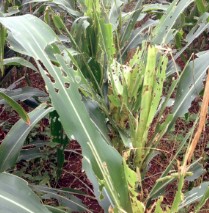By Thomas McCann
The potato leafhopper, Empoasca fabae, is a pest that is easy to overlook until the damage - called "hopperburn" - "burns" you. Photo: Penn State College of Agriculture
Wet weather and variable temperatures across the state continue to be challenging for vegetable and berry production.
Vegetable and berry growers in Pennsylvania have been contending with localized flooding; delays in herbicide application and cultivation for weed control; nutrient leaching; and lots of disease problems. Surprisingly for two pests more often associated with hot, dry weather, very high potato leafhopperand t wo-spotted spider mitepopulations have been observed in a number of vegetable (beans, potatoes, tomatoes) and berry crops (strawberries, brambles) over the past two weeks.
Berries
The strawberry crop harvest is winding down in most parts of the state. Growers have been dealing with several strawberry diseases including anthracnose, Botrytis, and Verticillium. In addition, black root rot of strawberryhas been reported. Millipedes have been found causing damage in strawberries, as well as spider mites in high numbers in several bramble fields. In good news, the blueberry crop looks quite good across most of the state. However, we are starting to see sporadic catches of spotted wing drosophila (SWD) in traps. This means that growers should monitor for this pest, and have materials on hand for crop protection as needed. An important addition for resistance management in pesticide labels is a supplemental label for Delegate WG on bushberries only (this covers blueberries) that allows three applications with a 1-day PHI, as long as the total amount used under with a 1-day PHI does not exceed 17.9 oz. This means that the maximum rate of 6 oz/acre for cannot be used for all three applications if applied only one day before harvest.

Black root rot is known as a "disease complex," meaning that it can be caused by several factors.
Female spotted-wing drosophila on raspberry.
Vine crops
Cucumber beetle populations are high in many fields, and we already see cases of bacterial wilt diseasethat is vectored by this insect pest. Exirel now has a 2ee label for cucumber beetle. Powdery mildew is showing up in squash fields; downy mildew has been confirmed in the Delmarva Peninsula, but not yet in Pennsylvania. Other vine crop diseases observed recently include angular leaf spot, anthracnose on watermelon, and Phytophthora in yellow squash and zucchini.
Sweet Corn
Pheromone traps for monitoring lepidopteran pests of sweet corn (European corn borer, corn earworm, and fall armyworm) are being set out around the state; reporting of trap counts has begun. Corn earworm catches have been mostly low, although counts of 20-25 per week occurred in Lycoming and Westmoreland Counties. Few European corn borer or fall armyworms have been caught through the last week of June, although there have been a few sites with strong captures of fall armyworm. For fall armyworm, it's not uncommon for feeding damage to vegetative corn to be detected prior to trap catch in the early part of the season. Check fields for fall armyworm feeding. Also, we sometimes still have problems of non-target trap captures in fall armyworm traps, especially from wheathead armyworm. See Identifying Non-targets from Fall Armyworm Pheromone Captures for diagnostic characters.

Fall armyworm feeding damage can sometimes occur prior to significant capture of male moths early in the season. Look for large, ragged feeding with lots of frass.
Tomatoes and Potatoes
Based on some additional testing, the incidence of late blight (Phytophthora infestans) reported earlier on tomato transplants from New York appears to be a new strain showing resistance to mefenoxam and also appears to infect both tomato and potato with about equal efficacy. Infected plants were destroyed. In the past 24 hours there have been two suspected reports of late blight on tomato and potato that are in the process of being confirmed. Although temperatures are going to turn hot, the cooler wet weather has been favorable for late blight. Vigilant scouting is recommended along with the use of protectant fungicides if you are not already applying them.
We have seen several cases of timber rot in high tunnel tomatoes, in some cases, quite severe. Spider mites have also caused significant damage in some high tunnels. Tomato flower abortion has been observed in some high tunnels, likely caused by temperature and humidity swings. In field-grown tomatoes, Septoria and early blight (Alternaria) are showing up on older leaves.
Dickeya and Pectobacterium were found on several cultivars of potato growing in south-central Pennsylvania. Potato blackleg and soft rot have also been observed in the field.
Sclerotia of Sclerotinia White Mold (Timber Rot) on a tomato stem.
Brown Marmorated Stink Bug Management Survey for Commercial Producers
A nation-wide survey is currently underway to gather information from farmers and growers on the economic impact of the brown marmorated stink bug (BMSB) on agriculture. The objective of the survey is to better provide you with the help you need in managing this pest. We’d like to find out when BMSB became a problem for you, where you currently get information on how to control them, how much damage you have suffered, your use of and interest in various management practices, and your feelings about biological control methods and their potential for your operation. The results of the survey will be used by Extension programs across the United States to fine-tune management advice for the BMSB and help prioritize research and outreach activities.
If you’d like to participate, the survey should take you about 20-25 minutes to complete. Your individual survey responses will be confidential and the data collected will only be reported in summaries. Your participation is voluntary, and you can decide not to answer a given question if you choose. The link to the on-line survey along with more information about the survey can be found on the StopBMSB.org website.